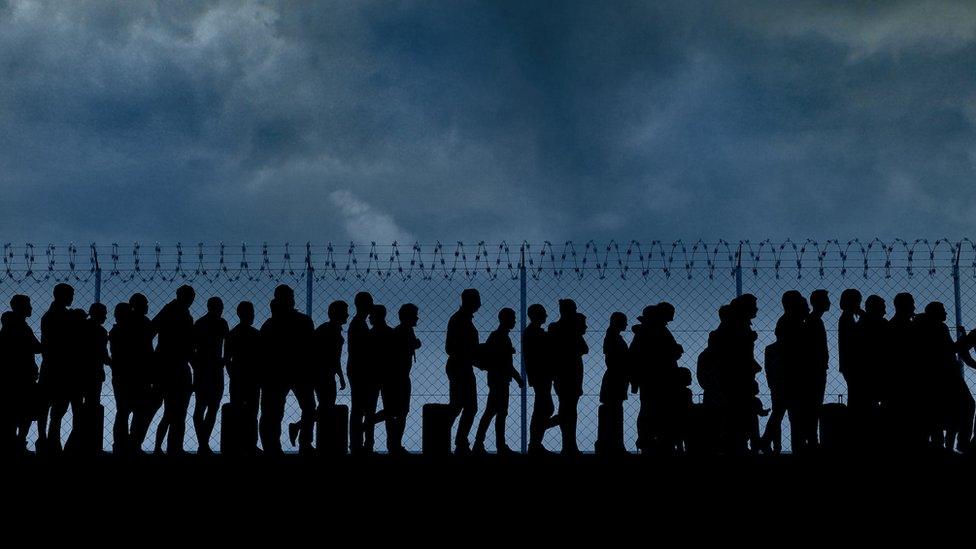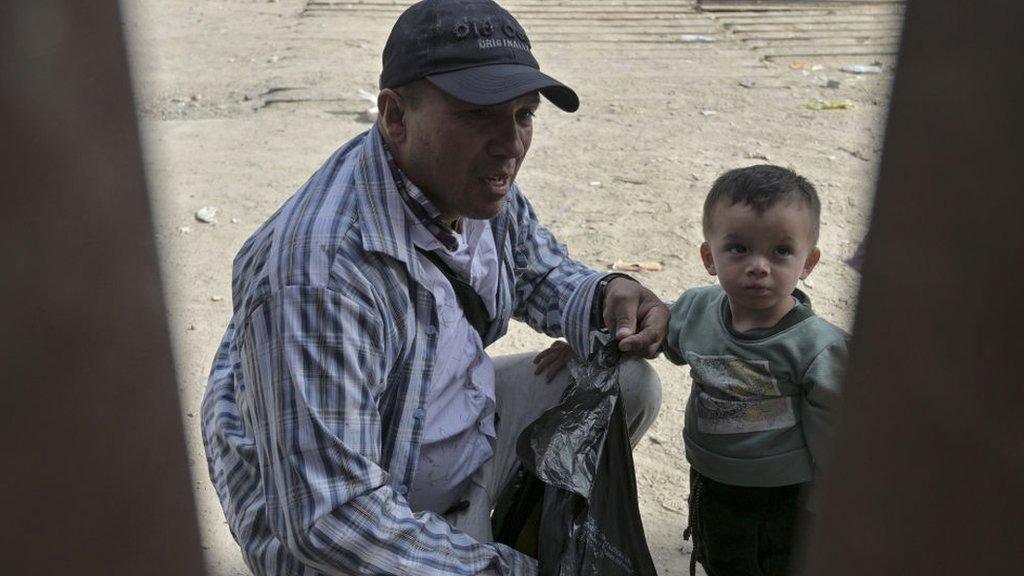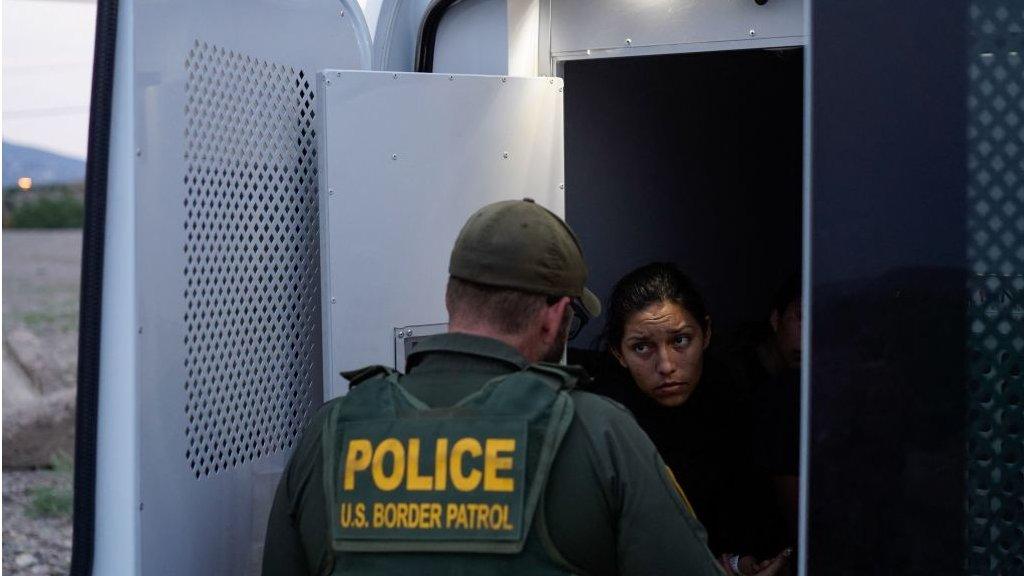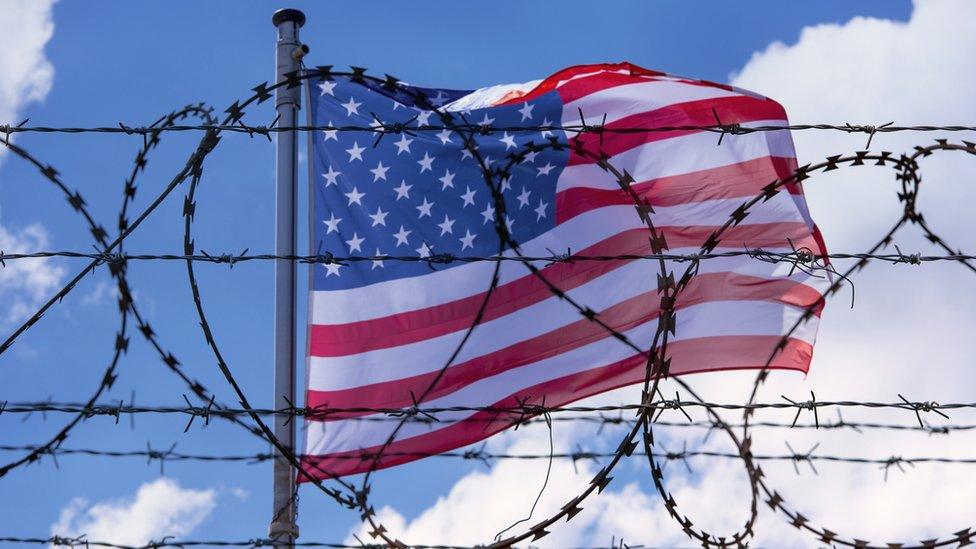How Joe Biden and Donald Trump's border policies compare
- Published

The Biden administration has long vowed to take a more 'humane' approach to US immigration policy.
Just after taking office, US President Joe Biden vowed to put an end to what he termed the "moral and ethical" shame of Donald Trump's immigration policies.
The Trump administration had adopted a strict border policy and the Biden White House promised a more "humane" approach.
Of the hundreds of immigration-focused actions the Biden White House has taken on the file, dozens have been aimed at reversing or undoing the policies of his predecessor.
But the Democratic president has faced criticism both from immigration advocates who say his policies are unduly harsh and from Republican political foes who say he has not done enough.
Here's how the two US presidents compare.
Sending migrants back
What Trump did: In March 2020, at the beginning of the Covid-19 pandemic, the Trump administration invoked Title 42, a controversial statute ostensibly meant as a public health measure.
The policy allowed US authorities to swiftly expel migrants - including asylum seekers - at the border.
Nearly 400,000 people were detained and expelled between its implementation and January 2021, when Trump left the White House.
Even at the height of the pandemic, Title 42 came under frequent criticism from those who argued the policy allowed the US to expel asylum seekers without any legal process.
Human Rights Watch, for example, said the policy was "illegal and violates the human rights of those subjected to it".
What Biden did: He defended keeping Title 42 in place, using the pandemic as justification.
Over two million people were expelled using Title 42 authority between January 2021 and 11 May 2023, when it, alongside the declared US coronavirus public health emergency, expired.
To replace it, US immigration authorities unveiled a "carrot and stick" approach that encourages legal pathways, while also implementing strict penalties for those who cross illegally.
The strategy included opening regional processing centres in Latin America to help migrants apply to come to the US, and expanded access to CBP One, an app for migrants to schedule asylum appointments.
A new, and long-awaited executive order on immigration unveiled on 4 June will also allow US authorities to swiftly deport migrants who enter the country illegally without processing their asylum requests.
That power will apply when a daily threshold of 2,500 migrant "encounters" is reached.
Removals are expected to take place within days, or even hours. The rule will not apply to migrants who arrive using legal pathways.
Notably, the executive order rests on a law - known as 212(f) - that allows a US president to "suspend the entry" of foreigners if their arrival is "detrimental to the interests" of the country.
The same regulation was used by the Trump administration to ban immigration and travel from several predominantly Muslim countries and to bar migrants from asylum if they were apprehended crossing into the US illegally, prompting accusations of racism.
Migrant mother tells children: 'We're on a quest to find the treasure'
Making migrants stay in Mexico
What Trump did: In January 2019, the Trump administration implemented a policy - officially known as Migrant Protection Protocols, or MPP - that forced asylum seekers to wait in Mexico for their US immigration hearings.
About 70,000 people were returned to Mexico under the policy. They were often left there for months at a time and sometimes preyed upon by criminal gangs.
Human Rights First, a charity organisation, estimated that more than 1,500 migrants were kidnapped, raped or abused after being returned to Mexico.
Mr Biden called the policy "inhumane".
What Biden did: The administration moved to suspend Remain in Mexico on Mr Biden's first day in the White House in January 2021. The Department of Homeland Security (DHS) moved to officially terminate the policy in June the same year.
But a ruling by a Trump-appointed federal court judge in Texas found that the administration had improperly cancelled the policy. It was restarted in December 2021.
In June 2022, the US Supreme Court sided with the Biden administration, ruling it didn't violate proper administrative procedure in rescinding Remain in Mexico. The ruling allowed the policy to be terminated.

Separating families
What Trump did: Under Trump, the US government had a "zero-tolerance" policy that allowed authorities to deport adults who crossed the border illegally.
In some cases parents were deported back to their home countries without their children, who were placed in government custody.
Trump repeatedly defended - and continues to defend - the policy as a way to deter would-be migrants.
At least 3,900 children were separated from their parents between 2017 and 2021.
What Biden did: Mr Biden reversed the practice and some families - but not all - have been reunited.
While a task force has reunited most families, as of April 2024 nearly 1,400 children were still waiting - although about 300 of them were in the process of being reunited or their families had been contacted.
In December 2021, the administration also moved to stop holding families in Immigration and Customs Enforcement (ICE) detention.
Biden administration officials have noted that the president's new executive order includes exemptions for unaccompanied children and those suspected of being trafficked.
The Biden administration has also rolled out family reunification programmes for citizens of certain countries - including Honduras, El Salvador, Guatemala and Colombia - who have relatives in the US.
Parole
What Trump did: Trump made little use of parole - where the government allows migrants into the US even if they don't have a visa or can't qualify for one - compared to President Biden.
Instead, his administration led an effort to decrease the number of migrants on parole in the US and in 2018 announced the creation of the MPP programme, or "Remain in Mexico".
Trump has said on the campaign trail that he would end the "outrageous abuse of parole" by President Biden.
What Biden did: Mr Biden is said to be one of the presidents rely most on parole, a practice which has existed since the 1950s. That has prompted fierce criticism from Republicans and Trump.
The use of parole by the Biden administration includes the humanitarian parole of migrants who have been detained, in particular when they are found to have a credible fear of persecution or torture in their home country.
There are also special, targeted parole programmes for people of specific nationalities, including Afghans and Ukrainians.
As many as 30,000 migrants a month are able to fly to the US legally on parole - with a sponsorship - under the programme for Cubans, Venezuelans, Nicaraguans, and Haitians.
The administration argues it has helped reduce crossings at the Mexico-US borders, but it sparked a lawsuit from multiple Republican-led states.
The scrapped border bill would have kept these programmes in place and allowed parole for those in humanitarian need, but broadly speaking would have restricted its use.
Related topics
- Published12 May 2023

- Published12 May 2023

- Published8 May 2023
